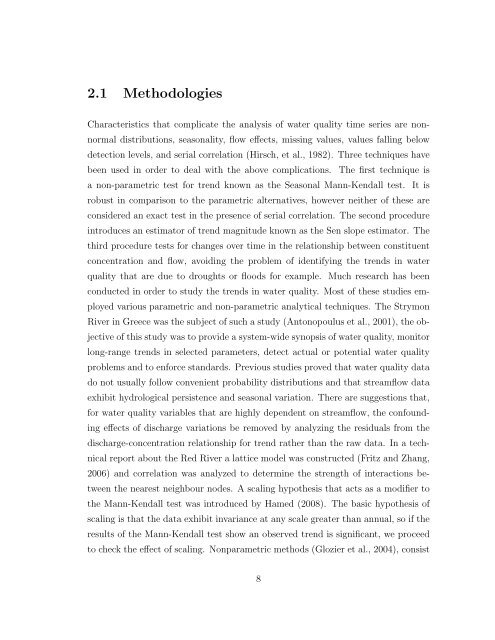Statistical Analysis of Trends in the Red River Over a 45 Year Period
Statistical Analysis of Trends in the Red River Over a 45 Year Period
Statistical Analysis of Trends in the Red River Over a 45 Year Period
Create successful ePaper yourself
Turn your PDF publications into a flip-book with our unique Google optimized e-Paper software.
2.1 Methodologies<br />
Characteristics that complicate <strong>the</strong> analysis <strong>of</strong> water quality time series are nonnormal<br />
distributions, seasonality, flow effects, miss<strong>in</strong>g values, values fall<strong>in</strong>g below<br />
detection levels, and serial correlation (Hirsch, et al., 1982). Three techniques have<br />
been used <strong>in</strong> order to deal with <strong>the</strong> above complications. The first technique is<br />
a non-parametric test for trend known as <strong>the</strong> Seasonal Mann-Kendall test. It is<br />
robust <strong>in</strong> comparison to <strong>the</strong> parametric alternatives, however nei<strong>the</strong>r <strong>of</strong> <strong>the</strong>se are<br />
considered an exact test <strong>in</strong> <strong>the</strong> presence <strong>of</strong> serial correlation. The second procedure<br />
<strong>in</strong>troduces an estimator <strong>of</strong> trend magnitude known as <strong>the</strong> Sen slope estimator. The<br />
third procedure tests for changes over time <strong>in</strong> <strong>the</strong> relationship between constituent<br />
concentration and flow, avoid<strong>in</strong>g <strong>the</strong> problem <strong>of</strong> identify<strong>in</strong>g <strong>the</strong> trends <strong>in</strong> water<br />
quality that are due to droughts or floods for example. Much research has been<br />
conducted <strong>in</strong> order to study <strong>the</strong> trends <strong>in</strong> water quality. Most <strong>of</strong> <strong>the</strong>se studies employed<br />
various parametric and non-parametric analytical techniques. The Strymon<br />
<strong>River</strong> <strong>in</strong> Greece was <strong>the</strong> subject <strong>of</strong> such a study (Antonopoulus et al., 2001), <strong>the</strong> objective<br />
<strong>of</strong> this study was to provide a system-wide synopsis <strong>of</strong> water quality, monitor<br />
long-range trends <strong>in</strong> selected parameters, detect actual or potential water quality<br />
problems and to enforce standards. Previous studies proved that water quality data<br />
do not usually follow convenient probability distributions and that streamflow data<br />
exhibit hydrological persistence and seasonal variation. There are suggestions that,<br />
for water quality variables that are highly dependent on streamflow, <strong>the</strong> confound<strong>in</strong>g<br />
effects <strong>of</strong> discharge variations be removed by analyz<strong>in</strong>g <strong>the</strong> residuals from <strong>the</strong><br />
discharge-concentration relationship for trend ra<strong>the</strong>r than <strong>the</strong> raw data. In a technical<br />
report about <strong>the</strong> <strong>Red</strong> <strong>River</strong> a lattice model was constructed (Fritz and Zhang,<br />
2006) and correlation was analyzed to determ<strong>in</strong>e <strong>the</strong> strength <strong>of</strong> <strong>in</strong>teractions between<br />
<strong>the</strong> nearest neighbour nodes. A scal<strong>in</strong>g hypo<strong>the</strong>sis that acts as a modifier to<br />
<strong>the</strong> Mann-Kendall test was <strong>in</strong>troduced by Hamed (2008). The basic hypo<strong>the</strong>sis <strong>of</strong><br />
scal<strong>in</strong>g is that <strong>the</strong> data exhibit <strong>in</strong>variance at any scale greater than annual, so if <strong>the</strong><br />
results <strong>of</strong> <strong>the</strong> Mann-Kendall test show an observed trend is significant, we proceed<br />
to check <strong>the</strong> effect <strong>of</strong> scal<strong>in</strong>g. Nonparametric methods (Glozier et al., 2004), consist<br />
8
















